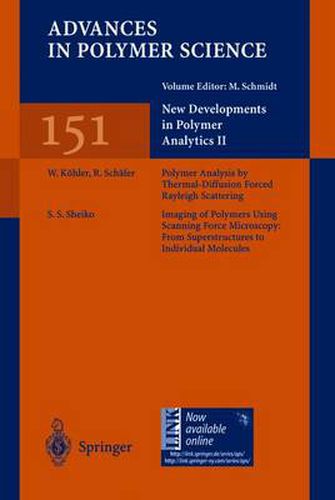Readings Newsletter
Become a Readings Member to make your shopping experience even easier.
Sign in or sign up for free!
You’re not far away from qualifying for FREE standard shipping within Australia
You’ve qualified for FREE standard shipping within Australia
The cart is loading…






This title is printed to order. This book may have been self-published. If so, we cannot guarantee the quality of the content. In the main most books will have gone through the editing process however some may not. We therefore suggest that you be aware of this before ordering this book. If in doubt check either the author or publisher’s details as we are unable to accept any returns unless they are faulty. Please contact us if you have any questions.
The two volumes New Developments in Polymer Analytics deal with recent progress in the characterization of polymers, mostly in solution but also at s- faces. Despite the fact that almost all of the described techniques are getting on in years, the contributions are expected to meet the readers interest because either the methods are newly applied to polymers or the instrumentation has achieved a major breakthrough leading to an enhanced utilizaton by polymer scientists. The first volume concentrates on separation techniques. H. Pasch summarizes the recent successes of multi-dimensional chromatography in the characteri- tion of copolymers. Both, chain length distribution and the compositional h- erogeneity of copolymers are accessible. Capillary electrophoresis is widely and successfully utilized for the characterization of biopolymers, particular of DNA. It is only recently that the technique has been applied to the characterization of water soluble synthetic macromolecules. This contributrion of Grosche and Engelhardt focuses on the analysis of polyelectrolytes by capillary electopho- sis. The last contribution of the first volume by Coelfen and Antonietti sum- rizes the achievements and pitfalls of field flow fractionation techniques. The major drawbacks in the instrumentation have been overcome in recent years and the triple F techniques are currently advancing to a powerful competitor to size exclusion chromatography.
$9.00 standard shipping within Australia
FREE standard shipping within Australia for orders over $100.00
Express & International shipping calculated at checkout
This title is printed to order. This book may have been self-published. If so, we cannot guarantee the quality of the content. In the main most books will have gone through the editing process however some may not. We therefore suggest that you be aware of this before ordering this book. If in doubt check either the author or publisher’s details as we are unable to accept any returns unless they are faulty. Please contact us if you have any questions.
The two volumes New Developments in Polymer Analytics deal with recent progress in the characterization of polymers, mostly in solution but also at s- faces. Despite the fact that almost all of the described techniques are getting on in years, the contributions are expected to meet the readers interest because either the methods are newly applied to polymers or the instrumentation has achieved a major breakthrough leading to an enhanced utilizaton by polymer scientists. The first volume concentrates on separation techniques. H. Pasch summarizes the recent successes of multi-dimensional chromatography in the characteri- tion of copolymers. Both, chain length distribution and the compositional h- erogeneity of copolymers are accessible. Capillary electrophoresis is widely and successfully utilized for the characterization of biopolymers, particular of DNA. It is only recently that the technique has been applied to the characterization of water soluble synthetic macromolecules. This contributrion of Grosche and Engelhardt focuses on the analysis of polyelectrolytes by capillary electopho- sis. The last contribution of the first volume by Coelfen and Antonietti sum- rizes the achievements and pitfalls of field flow fractionation techniques. The major drawbacks in the instrumentation have been overcome in recent years and the triple F techniques are currently advancing to a powerful competitor to size exclusion chromatography.